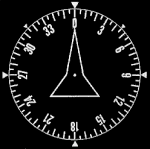Contents | Return to Chapter 3
 |
Instrument Flight |
|
If an airplane could be flown by concentrating on only one instrument, flight on the gauges would be easy. Normally, constant reference must be made to six basic flight instruments as well as the navigation and engine instruments. This is accomplished through the pilot's instrument scan; the instrument pilot's most basic skill. An important element of the instrument scan is cross-checking the readings of each instrument with other instruments to confirm an accurate interpretation. Consequently, the pilot never fixes his view on any single instrument for more than a few seconds with the occassional exception of the attitude indicator. Pilots are taught specific procedures for each phase of flight. For example, one manual's suggested procedure for leveling off from a climb is: note the altimeter; lower the nose on the attitude indicator; check for increasing airspeed on the airspeed indicator; check for constant heading on the heading indicator (the heading often swings to the right on level-off). Continue to monitor altitude, airspeed and heading until the desired airspeed is reached, then reduce power as required. Trim the aircraft's controls for straight and level flight.
An aircraft can be flown remarkably accurately with the six basic flight instruments, the basic principles for which were developed in the early 1930's.
The airspeed indicator is one of the oldest and most important of the flight instruments. It measures the aircraft's speed through the air by measuring the dynamic pressure of the airstream rushing against the moving airplane.
During cruise, the aircraft may be flown within a fairly broad speed range depending on whether fuel economy, range or flight time is the primary objective. However, in no case can the pilot allow the aircraft to slow to stall speed - at which point the wings can no longer sustain the aircraft - or accelerate to "red line," above which structural failure may result.
In the middle of the top row of the panel is the attitude indicator, or artificial horizon, the central element of the pilot's instrument scan. In instrument conditions, the attitude indicator replaces the natural horizon, showing the relationship of the nose and wings to the horizontal plane.
The attitude indicator is the only instrument that gives direct information about an aircraft's attitude. Each movement of the aircraft's controls is therefore made with reference to this instrument.
An altimeter is simply a barometer calibrated in feet instead inches of mercury. With an increase in altitude, since there is now less air above the airplane, the pressure is less. The altimeter measures this reduced atmospheric pressure and displays it as the aircraft's altitude.
To compensate for barometric pressure changes, the altimeter is frequently calibrated by the pilot by setting the current barometric pressure in the altimeter setting window using a small knob.
This electrically-driven instrument not only serves as a back-up to the attitude indicator in the event of its failure, but also measures the rate and quality of a turn.
In instrument flight turns are typically made at a rate of three degrees per second or less; steeper turns are considered dangerous. The quality of the turn is measured by the ball in the curved glass tube at the bottom of the instrument. A quality, or coordinated, turn balances centrifugal and gravitational forces keeping the ball centered.
The heading indicator, or directional gyro, uses an internal gyroscope whose stability provides accurate directional information once it is set to the correct heading. The gyro-stabilized heading indicator is required because of the errors that occur in the magnetic compass during turns, speed changes and even in turbulent air.
Because of drift errors, the instrument should be checked against the magnetic compass during straight and level flight at least once every 15 minutes. Like the altimeter, a set knob is provided for corrections.
The vertical speed indicator, or VSI, measures the aircraft's rate of climb or descent as measured by the change in the surrounding atmospheric pressure.
Because of the instrument's inherent delay or "lag," accurate climb or descent information is not available for several seconds. For this reason, the VSI is useful only as a back-up instrument in most flight maneuvers.
During instrument flight, the pilot must guard against spatial disorientation, or vertigo. This is caused by the motion-sensing organs of the inner ear becoming confused during instrument flight. This requires that the pilot develop a total sense of reliance on the flight instruments and disregard other indications of motion. The pilot can also minimize the possibility of vertigo by avoiding sudden head movements and abrupt flight maneuvers. If the symptoms of vertigo appear and the instruments confirm the aircraft is in straight-and-level flight, the pilot should hold the aircraft's attitude for a minute or two allowing the disorientation to pass. In addition to maintaining the aircraft's proper orientation using the flight instruments, the pilot also has navigation and communication responsibilities. In instrument conditions, responsibility for traffic avoidance lies solely with the flight controller on the ground. Is all of this as difficult as it sounds? No, not really. The basic instrument flying skills can be learned in a few hours by the careful student. Most modern aircraft, unlike the Cessna 195, are equipped with an auto-pilot, relieving the pilot of the need to constantly monitor the flight instruments. The key is to stay current and never, never take anything about instrument flight for granted. Sources: |

Page Top | Contents | Return to Chapter 3
 Airspeed Indicator
Airspeed Indicator Attitude Indicator
Attitude Indicator Altimeter
Altimeter Turn Coordinator
Turn Coordinator Heading Indicator
Heading Indicator Vertical Speed Indicator
Vertical Speed Indicator